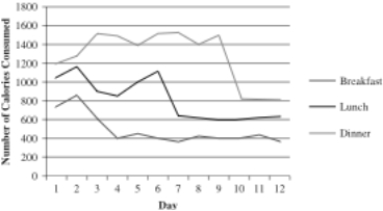Dr. Anderson is a nutritionist who helps clients lose weight prior to surgery. She is working with W. J., a male client who is planning on undergoing a heart transplant. He currently eats more than 3,500 calories a day and has been asked by his doctor to cut the number of calories to about 1,800 (400 for breakfast, 600 for lunch, and 800 for dinner) . She is curious as to whether a food journal will help W. J. reduce the number of calories he eats. A food journal is used to record everything a person eats to help patients be more aware of what they're eating. W. J.'s wife also recorded the food he consumed at each meal to have complete data before introducing the journal. Dr. Anderson decides to phase in the food journal gradually, initially only having W. J. record what he ate at breakfast during the first three days after baseline (days 4-6) . During days 7-9, the journal is used at lunch, too, and during days 10-12, it also is used during dinner. The data for Dr. Anderson's study are below.
If Dr. Anderson wanted to change the study to a stable-baseline design, which of the following would she change?
Definitions:
Accounts Receivable
Funds that are due to a company by customers who have purchased goods or services on credit.
Temporary Investments
Short-term financial assets that can be easily converted into cash, typically within a year.
Q5: It is difficult for lipid-soluble drugs to
Q10: Celexa
Q13: All of the following are types of
Q14: The pharmacokinetic phases control the _ of
Q16: Patients suffering from glaucoma will lose their
Q16: Dr. Farah is an educational psychologist who
Q16: Neely is examining the graph of an
Q25: When interrogating experiments, on which of the
Q47: Dr. Farah is an educational psychologist who
Q55: What do purposive, convenience, quota, and snowball